The trek from Lukla to Everest Base Camp takes between 11 and 14 days depending on weather conditions and rest days needed. This insider's guide to Everest Base Camp treks has everything you need to know about planning this epic adventure!
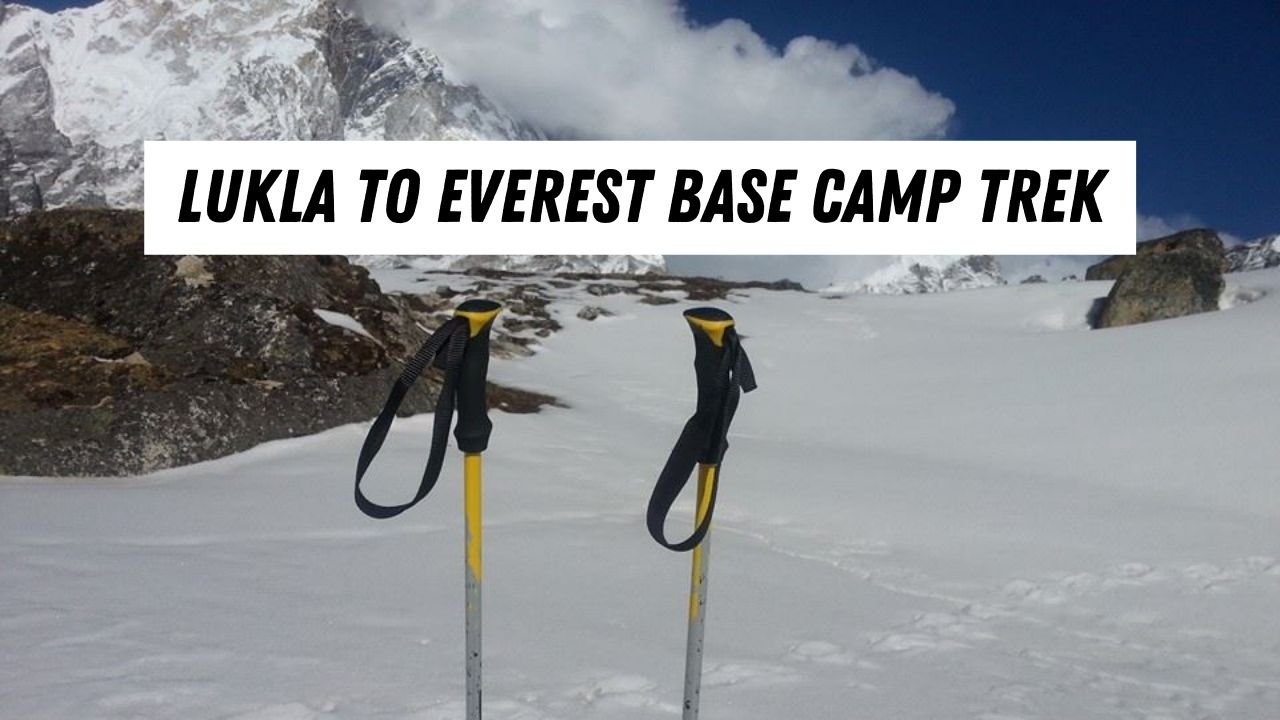
EBC Trek
Trekking from Lukla to the world's tallest mountain – Mount Everest – is an adventure of a lifetime! There's a lot of thing you need to know before you go, and so Saugat Adhikari, a seasoned hiker from Nepal and co-founder of a travel company in Kathmandu, shares some inside tips and advice which may prove to be invaluable in your travel planning.
Lukla to Mount Everest Trek
by Saugat Adhikari
I’m an avid trekker and have trekked most of the routes in Nepal and several areas of other countries. But one of my favorite treks is the epic adventure of the Everest Base Camp Trek (EBC Trek often known as the Mount Everest base camp trek) which starts from the high altitude airport at Lukla, situated in the Khumbu Region, as the Everest Region is called by the local residents, the Sherpas.
You may be familiar with this trek through the name ‘Everest’ – the highest mountain in the world. Unfortunately, I haven’t climbed those 8,848 meters above sea level to the top of the world – and I expect most of you reading this will also not be fortunate enough to summit the world’s highest peak. But for almost all of us, it is possible to reach the foot of the magnificent mountain at base camp. Which takes you above an impressive 5,000 meters into the Himalayas.
On route, you will experience the exhilarating flight into Lukla airport, also known as the Tenzing Hillary Airport (and known as one of the most dangerous airports!), visit Sherpa villages, meet the inhabitants of these mountains, and view the rugged, spiritual beauty of this region. And of course, you will be almost close enough to touch Mount Everest!
Make no mistake though, in this rocky terrain one has to go at a slow pace in order to trek safely and reach Everest Base Camp successfully. Sometimes people ask me “how far is the trek from Lukla to Everest Base Camp?” Well in Nepal we do not measure distance by miles, but rather by time. In the case of the trek to Everest Base Camp (also known as the EBC Trek), that is days. Read on!
Lukla Kathmandu Lukla Flight
More often than not this is a very early flight. But, if you are like me, the excitement of the Everest Base Camp Trek makes up for the early morning wake-up call.
And the excitement starts right here! Situated at 9,337ft/ 2,846m flying into Lukla, with its very short runway, is an experience you won’t forget – ever!
On the downside – the weather needs to be perfect for this flight and flights are frequently canceled. Because of this trekking in this region is not done during the monsoon season. And for this reason, I suggest you build in 3 or 4 contingency days before planning your post-trek itinerary. Particularly if you are heading straight for an international flight.
Interestingly you are allowed 10kg of baggage and 5kg of carry-on weight. But I really recommend you pack way lighter than that! Remember someone has to carry your luggage! Of course, there will be a porter and you will be only carrying a day pack, containing water, a camera, daily essentials, a first aid kit, and wearing your, already pre-loved hiking boots. Your companions for the entire trek.
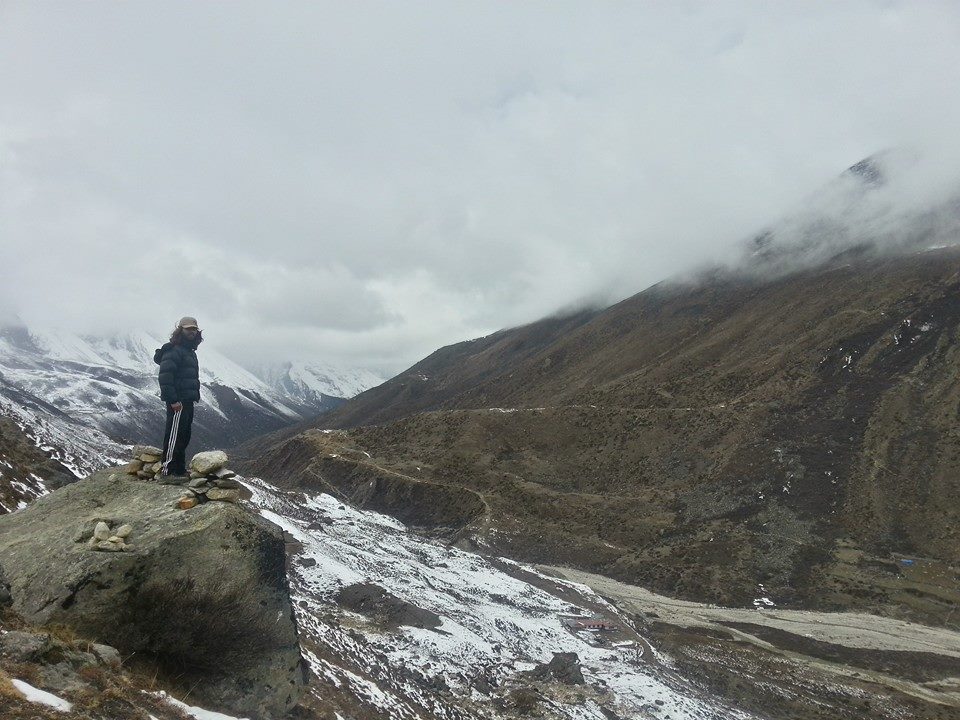
Permits for the Trek
For this trek, you need two permits, as requested by the Nepal Government, namely
Sagarmatha National Park Permit: NPR 3,000 or roughly USD 30
Khumbu Pasang Lhamu Rural Municipality Entrance Permit (a local government fee): NPR 2,000 or roughly USD 20
But what happens if you don’t have time to get the permits before leaving Kathmandu for the Everest Base Camp Trek? Don’t worry, you can now buy both permits on the trail itself.
Photographs are not needed to obtain the permits. TIMS (Trekkers' Information Management System) permits are no longer necessary for the Everest Region. Saves a lot of time and headache!
Best Time to do the Everest Base Camp Trek
I’m often asked when is the best time to do the Lukla to Everest Base Camp Trek. While there are two main ‘trekking’ seasons, I like the winter as there are fewer crowds and you can enjoy the serenity of the region without any distractions from other groups of trekkers. But wrap up warmly, it will be extremely cold.
However, the most popular times and the peak season to visit Everest Base Camp are:
Spring: March to May (May is also the main climbing season for the highest mountain in the world.)
Autumn: September to December (which is post-monsoon)
And of course, comparing experiences on the trails and making new friends in the lodges are a very big part of the overall experience for many people. The best time to meet new friends is in the busy season.
Read: Best time to visit Nepal
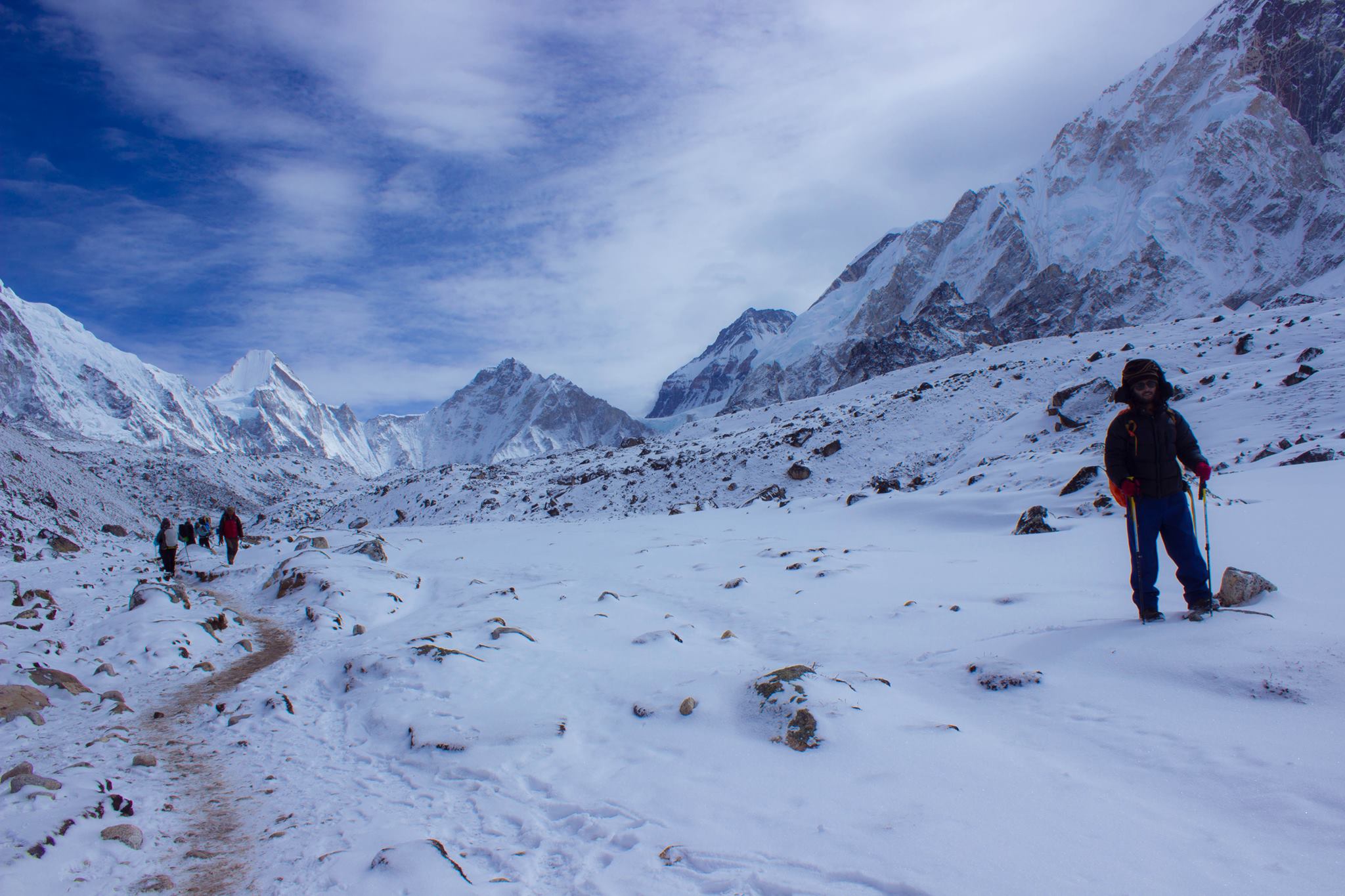
How Much Does it Cost to do the Everest Base Camp Trek?
The cost will depend on how you do the trek.
The cost of the flight is fixed – unless you want to add weeks to your journey and walk all the way from Kathmandu like the mountaineers of old! (Personally, I do not recommend it!) Airfare – $170 one way.
You can do this trek individually or with a trekking company.
With a trekking company or tour operator:
it will cost you approximately USD 1,200 to USD 2,500 with a local Nepali company. With an international company, it will cost you approximately USD 3,000 to USD 6,000.
Individually:
I do not advise you to trek independently unless you have considerable previous hiking experience. This should never be your first trek experience solo.
Remember this is the Himalayas and a slight error could cost you dearly, even if you follow the recommended rules, take a rest day or two and obey the laws of the gradual climb. Accidents do happen. But of course for minor injuries on your packing list should be a first aid kit. If you do decide to go alone, research via a good blog post or complete guide first.
For those who do wish to trek individually in the Everest Region, it will cost approximately USD 35 per day. I have broken this down to give you an idea of where your money will go
- Cost of food per meal: USD 5 to 6
- Cost of non-alcoholic drinks: USD 2 to 5*
- Cost of alcoholic drinks: USD 6 to 10
- Cost of accommodation: USD 5 to USD 150 (from tea houses to luxury lodge)
- Cost of a hot shower (yes you have to pay – it’s expensive to carry gas or firewood to the region): USD 4
- Cost of battery charge (again, electricity is limited, some will use solar): USD 2 to USD 6 for a full charge.
To save money, I recommend you carry your own solar charger or power bank for your phone. You can also reduce expenditure (and save the environment). Do you really need hot showers every day? Save even more by not drinking alcohol! It is not recommended to drink at high altitude anyway, but who can resist one or two evenings of good cheer around the fireplace.
*while food is included with an organized trek, alcoholic drinks will incur an extra cost.
Related: International Travel Packing Checklist
Trek Itinerary
It’s always a good idea to have an idea of what to expect on a day-by-day basis when trekking. So here is my breakdown of the Lukla to Everest Base Camp Trek.
Day 1 Kathmandu to Lukla by flight then trek to Phakding
To access the Everest Base Camp Trek it takes around 40 minutes to fly from Kathmandu to Lukla, then another 3 or 4 hours to trek to Phakding, the first overnight stop.
Please note, there have been some changes to regulations and so it is probable you will fly from Manthali Airport, around 4 hours from Kathmandu. That flight takes around 20 minutes but unfortunately, trekkers need to leave Kathmandu in the very early hours of the morning to catch the morning weather window.
In Lukla, the trekking trail takes us to Phakding. Although only 3 or 4 hours trek from Lukla, with the very early morning start from Kathmandu, that is enough walking on Day 1 for most people!
Day 2 Phakding to Namche
On day 2 the trail reaches the entrance to Sagarmatha National Park. It is here I feel I am really entering Sherpa territory, particularly as I’m trekking through traditional villages and yak pastures. Namche Bazaar is the largest village in this region, inhabited by those hardy Sherpas, and is the starting point for mountaineering expeditions.
Day 3 Acclimatization Day in Namche
Since Namche lies at almost 3,500m and the elevation gain only gets more from here, everyone must acclimatize to avoid altitude sickness. This is a great opportunity to head over to Everest View Hotel where there are great views of Everest! You can also visit the school set up by Sir Edmund Hillary which still educates Sherpa children today. And don’t forget to shop for any last-minute (snack) items before heading into the wilderness. Chocolate is always on my list!
Day 4 Namche to Tengboche
This is one of my favorite days – a day to take stunning photographs, and perhaps do some personal meditation and reflection. Tengboche is home to the highest Buddhist monastery in the region where you can meet some monks. Definitely, you will get great views of the surrounding mountains. The trek itself takes 5 to 6 hours passed Buddhist mani (prayer) walls and under prayer flags.
Day 5 Tengboche to Dingboche
It takes four to five hours of challenging walking to get to Dingboche – the highest Sherpa settlement in the region. Thankfully we reach in time for lunch and the rest of the day is spent relaxing under the gaze of Mount Ama Dablam and other surrounding peaks.
Day 6 Acclimatization Day in Dingboche
While trekkers acclimatize at this (relatively) lower altitude, (it is always wise to use caution and follow the recommendation not to climb high too fast to avoid altitude sickness) there are short hikes that can be enjoyed and which help acclimatize to the higher altitudes yet to come. My personal recommendation is a trip to the base of Nagkar Tshang Peak which takes 3.5 to 5 hours for a round trip. This is a sacred site with good views of Mt Makalu, the fifth highest mountain in the world (8,485m/ 27,838ft).
Day 7 Dingboche to Lobuche
Four to five hours of trekking = a paradise for photographers and nature lovers alike! This day takes me across a valley floor, through alpine scrub and yak pastures, and up through Thokla Pass, which is a bit challenging. There are great views of Ama Dablam and panoramic views of several peaks over 7,000m. And while its true Lobuche is not the most picturesque settlement, the surrounding scenery is extremely dramatic!
Day 8 Lobuche to Gorakshep (Afternoon hike to Kalapatthar)
While this trek is called the Everest Base Camp Trek, for my money, the most exciting part of the hike is that to Kalapatthar. From here (5,545m) the views of Everest are the best possible – much more clear than at Everest Base Camp. And this is the highest point we can trek to in Nepal without getting a climbing permit. Kalapatthar is actually a ridge and provides the best views of the world’s highest mountain! Overall the trail takes 6 or 7 hours to cover.
Day 9 Gorakshep to Pheriche (morning hike to EBC)
Again today’s hike takes 7 or 8 hours. I would like to point out here that the Everest Base Camp on this trek is not exactly the one where mountaineering expeditions set up camp.
The reason behind this is not to disturb the climbers as they prepare for their arduous climb and which may slow them down. But there is a great view of the comings and goings of their preparation from our own base camp, particularly in the busy climbing season.
The Khumbu Glacier is also spectacular in its icy beauty. After visiting Everest Base Camp the trek heads to Pheriche (4 hours away) where there is the Himalayan Rescue Association Clinic. Nice to visit but no one wants to have to call them out on a rescue mission!
Day 10 Pheriche to Namche
Leaving behind the rugged landscape of the mountains, forests, and greenery return as we get closer to Namche Bazaar. This is a hard 6 or 7 hours walk and definitely an evening to allow yourself that alcoholic drink or two! Wi-Fi is also available, which means I can let people know I have finished the trek and am on the way back to Kathmandu.
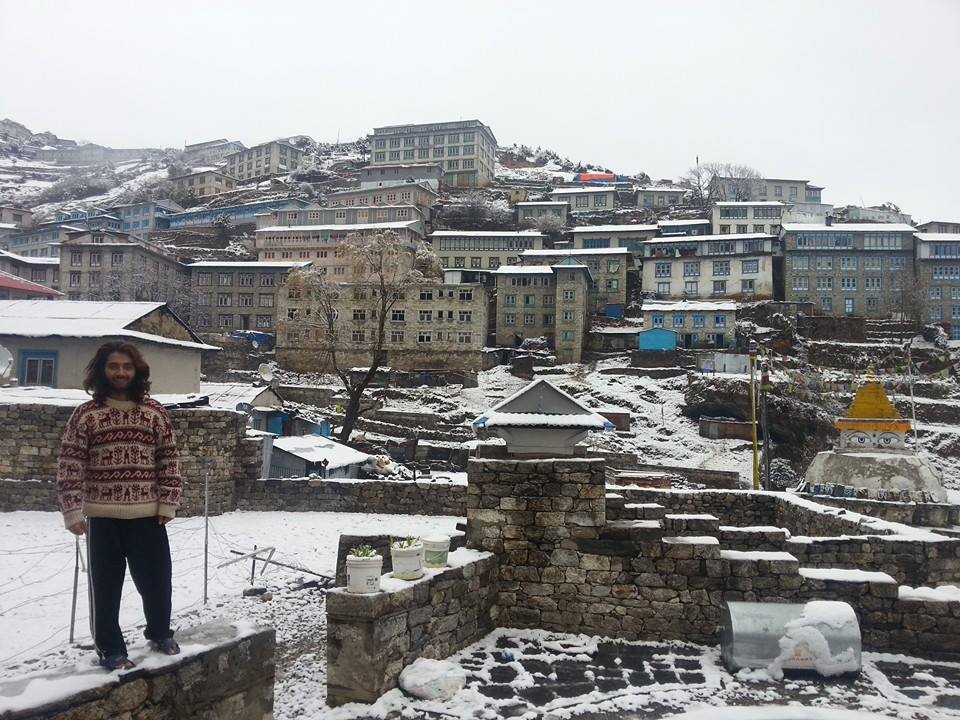
Day 11 Namche to Lukla
This is a sad day – heading on out of Namche and down to Lukla where it is necessary to overnight in order to make the early morning flight on to Kathmandu. Until the next time Mt Everest!
Accommodation on the Everest Base Camp Trek
The world is your oyster (sometimes) as far as accommodation on this trek is concerned. For the budget-conscious, there is lots of accommodation at the lower end of the price scale. Even for as little as USD 5 per night in some guest houses or tea houses.
If you prefer something more comfortable, there is the Everest View Hotel between Namche Bazaar and Tengboche (which I recommend you visit even for just a cup of coffee as the views are spectacular from here). Other comfortable hotels, mainly found at lower altitudes, include the Yeti Mountain Home group of hotels at Phakding and Lukla.
Lukla Hotels
- Yeti Mountain Home, Lukla Lukla
- Lama Hotel, Lama's Rooftop Cafe Lukla
- Lukla Airport Resort Lukla Chaurikharka
As far as availability is concerned, accommodation at Lukla can become difficult if (or more likely, when) flights are delayed and there are many trekkers waiting in Lukla and seeking rooms. In Namche Bazaar there are around 50 rooms to suit every budget.
As you can imagine, it gets pretty busy here in the peak seasons as it is the jumping-off spot for many expeditions and treks. In other towns, accommodation is on the simpler side and sometimes more difficult to obtain.
For example, at Tengboche, there are only a handful of hotels and with people wanting to attend morning prayers (thus having to stay overnight beforehand) it might be better to trek downhill to Deboche, only 15 minutes away.
If you are going on an organized Everest Base Camp Trek you shouldn’t have to worry about accommodation as the company will do that for you. If trekking individually, be prepared to have to share with another trekker or sleep in the dining room if it's busy or flights are delayed. It simply adds to the experience!
Regardless of whether going with one of the many trekking companies or going independently, a sleeping bag is handy. In even the most comfortable of hotels you might be glad for just a little more warmth!
Food on the Mountain
I think you will be surprised at how tasty and varied the food is on the Everest Base Camp Trek. You may also be surprised at how hungry you are while hiking for hours every day. This is where stocking up on easy-to-carry and eat snacks at Kathmandu or Namche Bazaar comes in handy!
Meantime breakfast at all lodges, guest houses, and hotels along the route take on a similarity. Porridge, noodles, bread, and a hot drink such as tea and coffee. For your evening meal, you might be surprised by a whole menu of Western and Nepali items from pizza (with yak cheese) and soups to curry and rice.
Dal Bhat Power 24 Hour!
Lunches are mostly taken at a tea house along the trail and are somewhat more simple. Dal Bhat (a Nepali staple) will feature heavily. Each cook (or household) prepares it a little differently so it’s never boring.
I would suggest you avoid meat on the menu as most places above Namche do not have fridges and so you never can be too sure how fresh the meat is. To stay healthy on any trek is the number one way to enjoy your trip!
Regarding the price – above I have said to budget between USD 5 to 6 per meal. That is for the basics only. Remember that most items have to be brought in from Lukla airport via porter or yak. If you want to add a dessert to your evening meal, that will cost you more! Note there are bakeries at Lukla, Namche and Tenboche. Particularly nice on the way back from base camp and a change from Dal Bhat and porridge!
Over all, it’s up to you how much you want to spend on food on the Everest Base Camp Trek. Alcoholic drinks are extremely expensive as they are brought in by yak and porter!
In Conclusion: Is Trekking to Everest Base Camp Worth it?
In a word – yes. The Everest Base Camp Trek is well worth the effort!
And as I said, the Everest Base Camp Trek is one of my favorite trekking routes and the best trekking experience. Seeing the highest mountain – Mount Everest – in the world is truly awesome!
Don’t forget there are many other treks around the Everest Region. This is just the most popular and normal route. Other trails also include a trek to Everest Base camp, all of which involve awesome scenery, snow, and ice. And equally as awesome Sherpa hospitality.
Related: Snow quotes for Instagram
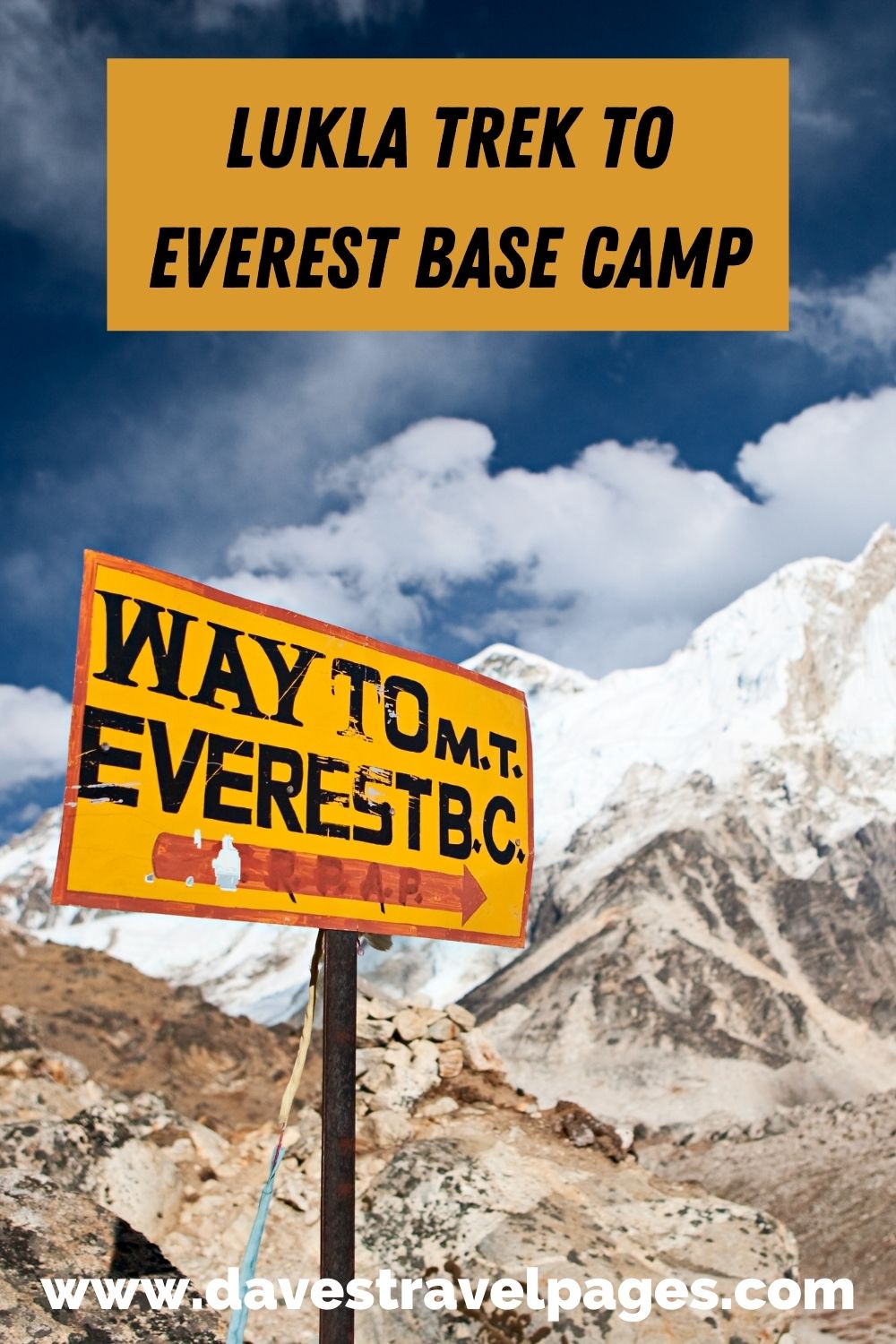
Lukla trek to Everest Base Camp FAQ
Some of the most frequently asked questions readers have about the EBC hike include:
How long is the trek from Lukla to Everest Base Camp?
While the distance from Lukla to base Camp at Everest is about 38.5 miles or 62 kilometers one-way, it is better to think of the trek in terms of the days needed which can vary between 11 and 14 days depending on circumstances.
How far is the walk from Lukla airport to Everest?
The walk from Lukla airport to Everest Base Camp is about 38.5 miles or 62 kilometers one-way.
How much does it cost to trek to Everest Base Camp?
International tour companies charge somewhere between 2000 and 3000 USD for the experience, which normally includes flights. A local company will probably charge half that amount.
Is trekking to Everest Base Camp worth it?
The trek to Everest Base Camp is definitely worth it if you're looking for an adventure. The views along the way are stunning, and you'll get to see Mount Everest up close. Plus, the experience of trekking in the Himalayas is unforgettable.
You might also want to read:
-
50 Trekking Quotes To Inspire You To Enjoy The Great Outdoors
-
Over 200 Of The Best Mountain Instagram Captions You’ll Find Anywhere
 Article Author: Dave Briggs
Article Author: Dave Briggs